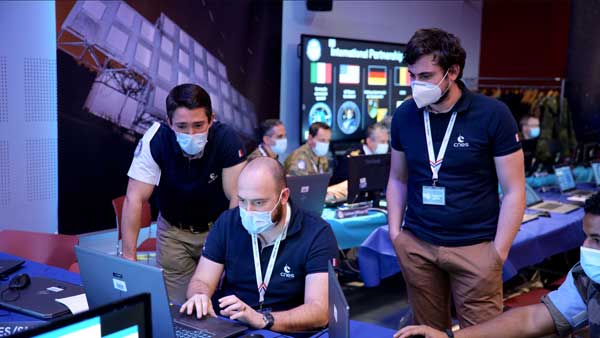
TOULOUSE, France (CNES PR) — The AsterX 2022 exercise took up residence at the Cité de l’Espace in Toulouse from 24/02 to 4/03/2022. This space threat simulation exercise, entirely piloted by the Space Command, is the second to be organized in close collaboration with CNES.
The objective of this exercise, the first edition of which took place in March 2021 at CNES: to define and test certain operational processes in the field of Space Situational Awareness and to test our reaction capacities in emergency situations. A unique operation in Europe.
Representatives of various units of the Space Command (CDE), CNES and certain industrialists, such as Airbus, Safran, ArianeGroup, CS Group or ONERA, take part. That’s a hundred people in all.
Concretely, the scenario is based on a fictional geopolitical conflict between armed forces and is the sequel to AsterX 2021.
“This exercise, prepared for a year, consists of defining a geopolitical scenario in a fully simulated space environment where there are satellites, space debris, etc.”, specifies Vincent Schaeffer, specialist in space surveillance at CNES and coordinator of the event on the CNES side. “Players are going to have to identify threats and act accordingly.”
If they know the title, the theme and the spatial capacities implemented, the “players” do not know the scenario because the script of this simulation will be revealed to them day after day, in order to get as close as possible to a real crisis management situation.
And in order to carry out the maximum possible actions, the equivalent of 24 days of conflict will be simulated over the 6 days of the event.
An exercise which thus makes it possible to enhance the expertise of CNES at multiple levels and to support the CDE in its rise to power in the space field.
The Role of CNES
Although organized by the Space Command, CNES plays a major role in the ASTERX exercise. This indeed requires a very strong involvement of our teams in terms of its preparation, its animation and its execution. In total, around ten engineers and several CNES subcontractors have been involved at different levels over the past year, from design to construction.
Development of the Scenario
CNES’s expertise is, for example, at the heart of the definition of relevant scenarios: the teams took part in the working group in charge of developing the scenario for the exercise and they contributed to the definition of the various threats (reconciliation between satellites, object avoidance, etc.) and their translation into technical data in the simulation environment.
“We worked very closely with the CDE, them for the military part, and us for space expertise, in particular for everything relating to space surveillance, satellite operations and the conduct of missions“, explains Vincent Schaeffer.
Creation of a Simulated Space Environment
Experts in security, safeguarding and mastery of space also provided a simulated space environment for this exercise. This contains 6,000 objects in orbit and offers more than ten scenarios, each constituting a threat to national and allied satellites. Two scenarios in particular required extensive expertise in space mechanics for the calculation of orbital maneuvers.
“We have created fictitious orbits that are as representative as possible of reality. 6,000 objects is 3 times less than in reality, but it’s something very complicated to do. It takes real experience and skill to generate all these orbits in line with the established scenario.”
CNES, in tandem with CDE, also coordinates the group responsible for generating and simulating technical orbital data, based on measurements from various sensors. Concretely? “For example, one team is in charge of monitoring the geostationary arc where there are a lot of communication satellites, another will watch the lower orbits using radars.”
Participation in the Exercise
Several CNES experts are taking part in the exercise itself, within the “control centre” and “space surveillance” entities. They are responsible for injecting information related to CNES activities, for example by simulating satellite anomalies or risks of collisions, and advising the CDE on avoidance maneuvers for example. Others intervene during the exercise by implementing various orbital data processing software developed at CNES.
“What should be remembered is that everything CNES is doing during this exercise is what we are already doing on a daily basis with the Space Command”, concludes Vincent Schaeffer.
CNES thus once again demonstrates its expertise, the synergies that exist between the civil and military aspects of space surveillance, but also its relationship of trust in its collaboration with the Space Command.
— Vincent Schaeffer
Why the Name AsterX?
In addition to the Gallic wink linked to the history of the famous comic strip, whose 1st album was Asterix the Gaul, this name refers to the first French satellite A-1, also named Asterix, and put into orbit by the Diamant rocket -A n°1 from Hammaguir, in the Algerian desert, on 11/26/1965.

